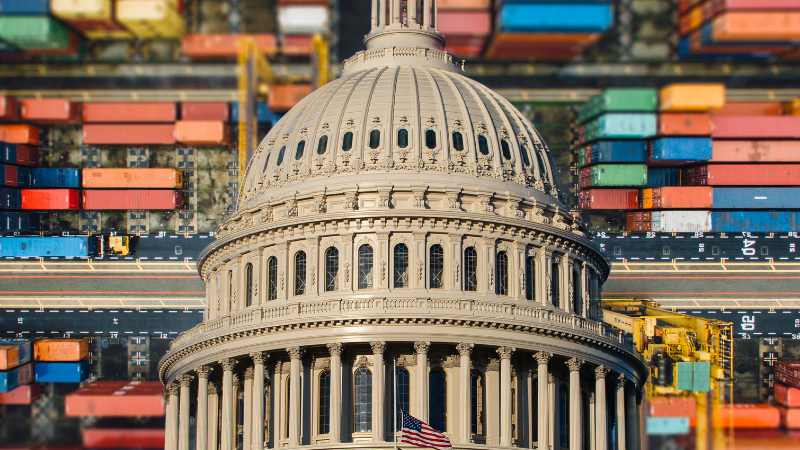
After nearly two months of White House seesawing on tariffs, the only certainty for a dizzied food-away-from-home industry appears to be more uncertainty.
The steep “reciprocal” surcharges Trump Administration officials described as permanent early Wednesday were suspended by the president hours later for 90 days. The one exception was the duty on Chinese imports, which the White House recalculated to total about 145%.
But the 10% "baseline” tariff imposed on goods coming from virtually every other country was left in place—except, that is, for the Mexican and Canadian imports that are covered by a no-tariff agreement struck during Donald Trump’s first term. Most foods and beverages provided by those nations are covered, though administration officials weren’t sure at first. Their initial “no” became a “yes.”
Wait—there's another asterisk. Steel, aluminum, autos and auto parts will still be subject to a 25% import duty.
Confused yet? You’re not alone.
The zigs and zags by the White House have brought a tsunami of coverage analyzing the political fallout but very little calculation of the impact on restaurants, convenience stores, college foodservices and other food-away-from-home channels.
The most exact assessment to date has been the National Restaurant Association’s projection of how the Mexican and Canadian tariffs as proposed in March would affect the margins of restaurants. In a letter to Trump imploring him to exempt foodstuffs from the 25% duties then under consideration, association CEO MIchelle Korsmo cited research showing the surcharges would cost U.S. restaurants $12 billion and about one-third of a mom-and-pop's margins.
Calculating an updated impact figure has been difficult for all parties because of the complexity of Trump’s tariff plan. The president proposed differing assessments on about 50 nations on April 2, explaining that the scale reflected what sort of import duties those countries have placed on American goods. The rates ranged from 20% (on European imports) to 46% (on goods from Vietnam.)
“The announcement is pretty complicated, and it will take some time to sort through what it says and what it means,” Andy Harig, VP of Tax, Trade, Sustainability and Policy Development for FMI The Food Industry Association, said in an email immediately after Trump’s plan was revealed on April 2.
Within hours, the White House tweaked the rates, raising the top fee (now on Thailand) to just under 50%.
Other implications of the tariffs have come to light since then. For instance, China responded to Trump’s tariffs by raising the duties on U.S. imports to 125%. The surcharges would apply to the output of U.S. farmers and food processors, including poultry producers.
The surcharges could discourage the sale of chicken feet in China, where that part of the bird is a staple. Because of the sales proceeds from what would be a discarded component in the U.S., American producers can charge less for other poultry cuts. Now that subsidy could be lost, meaning the price of breast meat, wings and whole birds could rise for domestic restaurants.
Yet little has been said about that possibility.
What the industry’s doing
Similarly, little has come to light about what the food-away-from-home industry is doing to contend with the tariff’s impact.
In February, Chipotle Mexican Grill told shareholders that it was preparing for what was then expected to be restrictive tariffs just on imports from Mexico, Canada and China. About half the Tex-Mex chain’s avocados come from Mexico, leaving it vulnerable. But CEO Scott Boatwright revealed the company was cultivating alternative sources elsewhere in Central and South America.
Then came Trump’s April 2 announcement that virtually all countries would subject to tariffs. Among the few exceptions: Mexican food imports.
Ironically, Boatwright noted during the same call with financial analysts that Chipotle was investing in more efficient kitchen equipment. The tariffs on steel and other metals used in fabrication are expected to hike the cost of those back-of-house elements.
The New York Times reported Thursday that chefs of higher end restaurants are stockpiling ingredients whose price could be pushed beyond the establishment’s reach when the tariffs are levied, like Szechuan peppercorns.
Others indicated they’re commissioning U.S. growers to plant certain products that are now imported, like Mexican corn.
Several said they’re already re-engineering recipes to eliminate what they expect to be particularly pricey ingredients.
FMI has recommended that members “keep your powder dry and expect the chaos.”
“We are not going to have certainty on what the supply chain is going to look like anytime soon,” Harig wrote to members of the association’s Government Relations and Public Affairs Committee. “Tariffs could be stopped and started several times, and the President can increase or decrease them virtually as he sees fit.
“It is going to be a mess for a while yet, so think about how to be nimble and cautious at the same time.”
The U.S. business community’s Hail Mary could be turning to the courts. The Wall Street Journal reported Tuesday that a number of trade associations are considering a joint lawsuit to challenge the legality of the Trump tariffs.
The only groups identified in the story were the U.S. Chamber of Commerce and the Consumer Technology Association.
As Managing Editor for IFMA The Food Away from Home Association, Romeo is responsible for generating the group's news and feature content. He brings more than 40 years of experience in covering restaurants to the position.